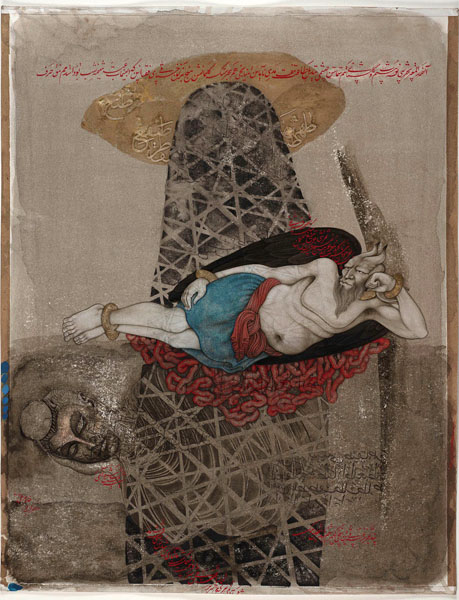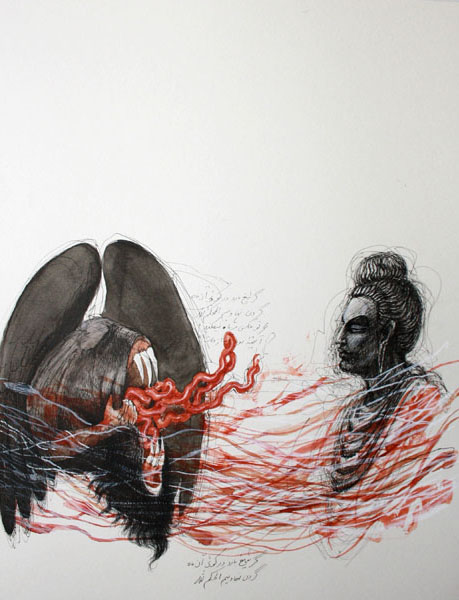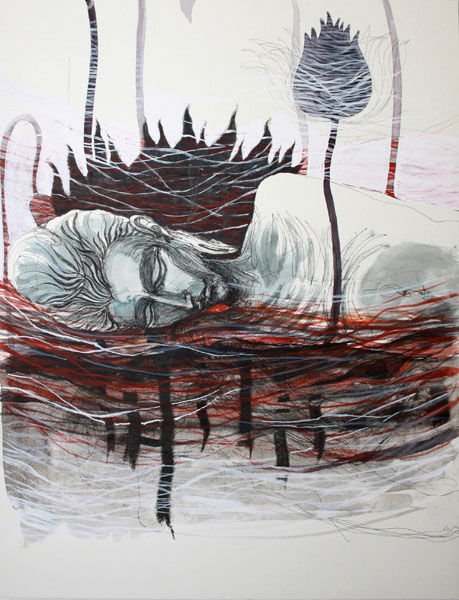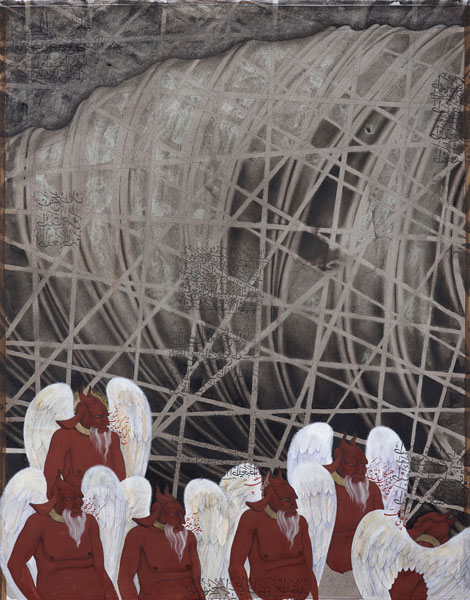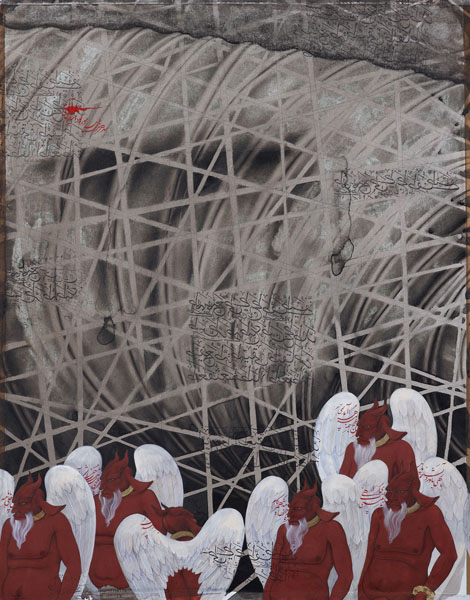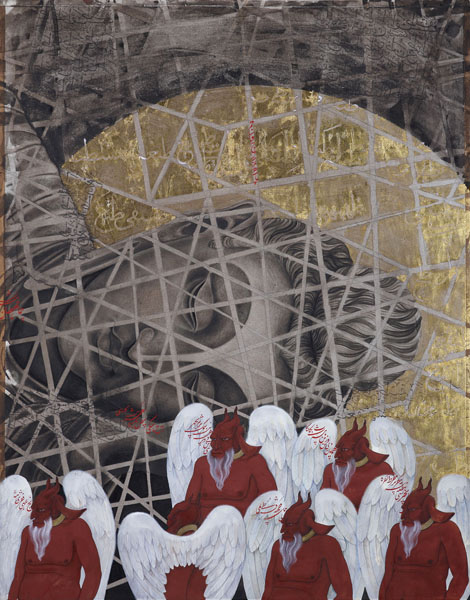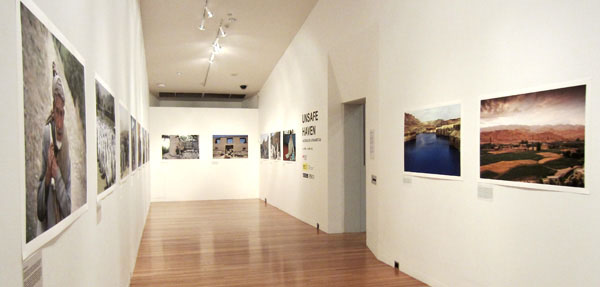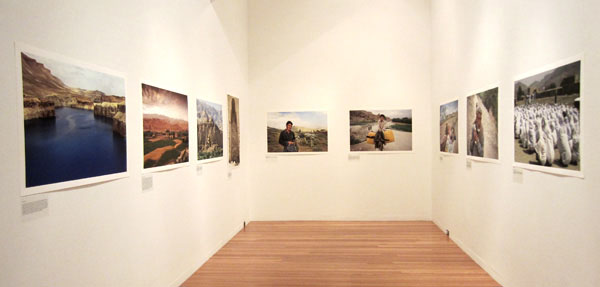
The Haunted Lotus: Contemporary Art from Kabul — 30 October to 4 September 2010
The difficulties faced by artists in Afghanistan will be dramatically on view in the exhibition The Haunted Lotus: Contemporary Art from Kabul. This war-torn country is now known better for anarchy than aesthetics.
Curated by celebrated artist Khadim Ali, The Haunted Lotus meditates on modernity and tradition, beauty and the bleakness of ‘permanent war’. Ali hopes ‘The project conveys to those of us in the West, the reality of life in Afghanistan’. Represented here are the ‘bare life’ aesthetics of those struggling to rebuild.
Khadim Ali’s colleagues — Ali Baba Aurang and Sher Ali — teach in Kabul for the Emerald Mountain reconstruction project and its new Institute of Afghan Arts. The show also includes drawings by Zainab Haidary, a student representing the hopes of the coming generation. The medium is modern interpretations of the two genres that historically define the region — calligraphy and miniature painting.
These intense drawings on their tattered papers salvaged from Iran and Soviet-times open a window to the daily lives of artists in civil war conditions. Many artists have changed professions. The civil war destroyed the Afghan art rebirth in 1970s and, later, the Taliban declared art a crime (against the state) and a sin. Human Rights Watch says Afghanistan is now a more dangerous country especially for women and Hazara people, a Shi’a minority.
Turquoise Mountain Foundation, founded in 2004, is creating jobs in arts and crafts and rejuvenating the old Kabul city centre. Turquoise Mountain Foundation then established the Institute for Afghan Arts and Architecture in Kabul, with co-patrons Prince Charles and President Hamid Karzai.
Beyond the immediate effects of fear, violence, and the destruction of human life, the long war internally displaced many or forced people to flee as refugees. For the last eight years Australia has waged a battle against terrorism and engaged in military conflict in Aghanistan. Ironically, military occupation has initiated a cycle of displacement, economic hardship, and cultural alienation that creates the conditions for new waves of extremism and repressive regimes.
For asylum seekers in Australia this has been a hot topic since the Tampa incident of 2001. Here people are marginalised in public discourse around refugees, asylum seekers and human rights. This exhibition engages with the process of equitable discourse with the people of Afghanistan.
Artwork featured in The Haunted Lotus: Contemporary Art from Kabul
Artwork featured in The Haunted Lotus: Contemporary Art from Kabul
Artwork featured in The Haunted Lotus: Contemporary Art from Kabul
Artwork featured in The Haunted Lotus: Contemporary Art from Kabul
Artwork featured in The Haunted Lotus: Contemporary Art from Kabul
Artwork featured in The Haunted Lotus: Contemporary Art from Kabul
Artwork featured in The Haunted Lotus: Contemporary Art from Kabul
Artwork featured in The Haunted Lotus: Contemporary Art from Kabul
Artwork featured in The Haunted Lotus: Contemporary Art from Kabul
About the Artists
Khadim Ali: incorporates classical miniature techniques, learnt at Lahore’s celebrated National College of Arts, to allude to the persecution of Hazara people by the Taliban and the destruction of the Bamiyan Buddahs. His perfect brushwork presents scenes from the Shahnameh, a Persian epic familiar to generations of Afghan children.
Ali’s hero, Rustam, is ambiguous, portrayed as both beautiful and a sinister demon, often armed with AK-47s, bayonets and grenade launchers. With his demon theatre, Ali presents the shifting meanings of heroism: the Taliban were once the mujahideen, freedom-fighters against the Soviet invasion; now Taliban militants declare themselves to be the new ‘winged Rustam’ to mythologise their violence. Meaningless letters and perverted meanings are propaganda for religious fundamentalism. In war anything can be co-opted. Khadim Ali lives in Sydney and works in Kabul and Quetta. He is an Afghan Hazara born as a refugee in Pakistan.
Ali Baba Aurang: lives in Kabul and his remarkable calligraphic paintings conjure Afghanistan’s devastation by decades of war. Words and text became an outlet for many artists during the Taliban’s rule, when creating figurative images was (and remains) dangerous. Ali Baba Aurang trained as a painter who now works in calligraphy. Executed in sombre brown-black with the occasional blue (all homemade inks on old sometimes Soviet era papers), Aurang’s texts shift from precise poetic renditions to dark abstracts suggestive of the brutality of daily life in one of the world’s poorest countries.
Sher Ali Hussainy: born in Kabul and studying at Beaconhouse National University, Lahore, Pakistan on a South Asian Association (SAARC) scholarship. Studied miniature painting for six months with Khadim Ali in Karachi and Turquoise Mountain Foundation, Kabul. Teaches at Marefat High School, Kabul and as a volunteer teacher at Turquoise Mountain Foundation.
Zainab Haidary: studying at the Department of Fine Arts, Kabul University.
About the project
This exhibition follows Khadim Ali and Jayce Salloum’s exhibition Bamiyan (the heart that has no love/pain/generosity is not a heart) at UTS Gallery in 2010. In 2008, the artists travelled to the Bamiyan Valley to document the Taliban destruction of 5th century Buddha statues in 2001. The ruins provided a site to talk about the situation of the Hazara people, a persecuted Shi’a Muslim minority descended from the sculptors of the colossal figures. The Taliban treated the Hazara brutally, killing them and burying them in mass graves.
Today the Taliban wage an insurgency in the south and east of the country, their control being confined to the border area between Afghanistan and Pakistan. In Bamiyan, when Ali asked children to draw the story of Rustam, they pictured Taliban and war, massacres and the destruction of the Buddha statues.
Thanks
In Kabul to Asad Buda, philosopher, for the title concept Haunted Lotus; Ms Hazrat Hava, social worker; in Sydney to Ruark Lewis, Tania Creighton and UTS Gallery; in Canada to Jayce Salloum, Haema Sivanesan and SAVAC, Toronto Canada.
Khadim Ali and Jayce Salloum, Bamiyan (the heart that has no love/pain/generosity is not a heart), UTS Gallery 2010.
Ali Baba Aurang’s works (catalogue nos 12 and 14) use lyrics from
‘Afghanistan we love you’ / ای نینوای جاویدان
Singer: Zahir Howaida; Lyrics by Ay Nainawa E Jawaden
http://www.youtube.com/watch?v=ELYGu5c0NMI&feature=related
Followed by: Only From The Heart Can You Touch The Sky
RMIT Gallery, Melbourne, 12 April to 9 June 2012
Drawing its title from a poem by Movlana Jalal al-Din Rumi, the celebrated 13th-century Persian mystic poet, Only From The Heart Can You Touch The Sky focuses on the fusion of art and poetry.
The exhibition features paintings by Hazara artists Khadim Ali (Australia-Afghanistan) and Ali Baba Awrang (Afghanistan), calligraphy by Iranian poet and playwright Mammad Aidani, as well as Persian rugs.
We usually view these cultures from the perspective of conflict. Here, we are invited to reflect on the fact so many people arriving in Australia as refugees — sometimes as ‘boat people’ — are the inheritors of living cultures.
Sydney-based Khadim Ali, whose works have been exhibited internationally and at The Cross Art Projects, trained in miniature painting at the National College of Arts, Lahore, and draws on imagery from sources including the Bamiyan Buddhas.
Kabul-based Ali Baba Awrang has been creating calligraphic art for 20 years.
Mammad Aidiani (Melbourne) has researched and published on Iranian diaspora, belonging, identity, and migration, and will respond to the artworks using freeform poetry in Persian script.
The show is in association with Love and devotion: from Persia and Beyond at the State Library of Victoria.

